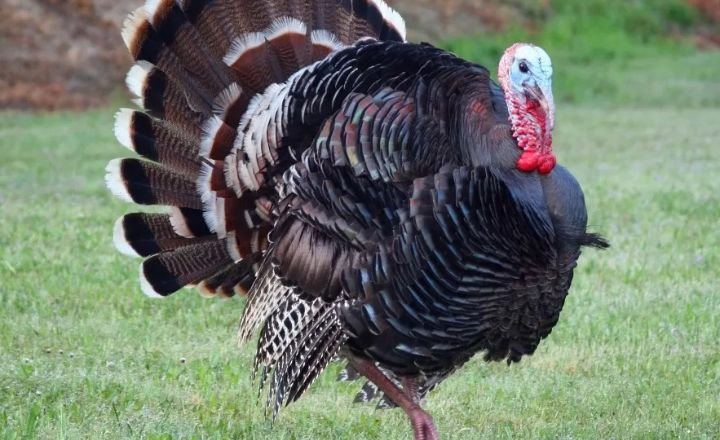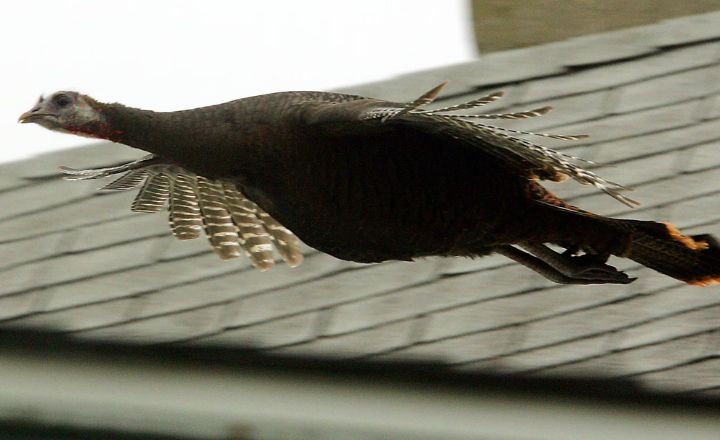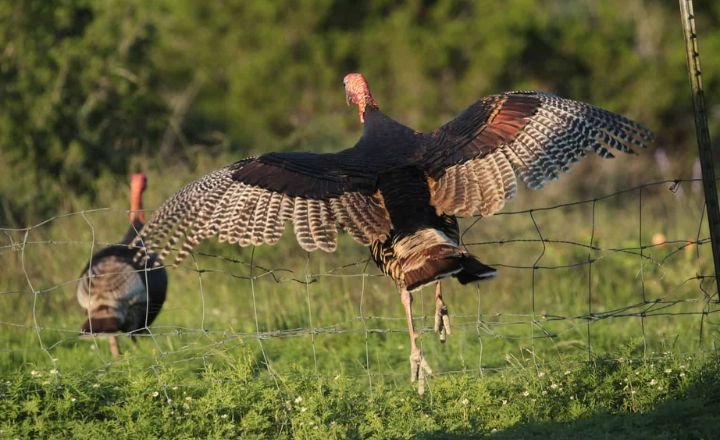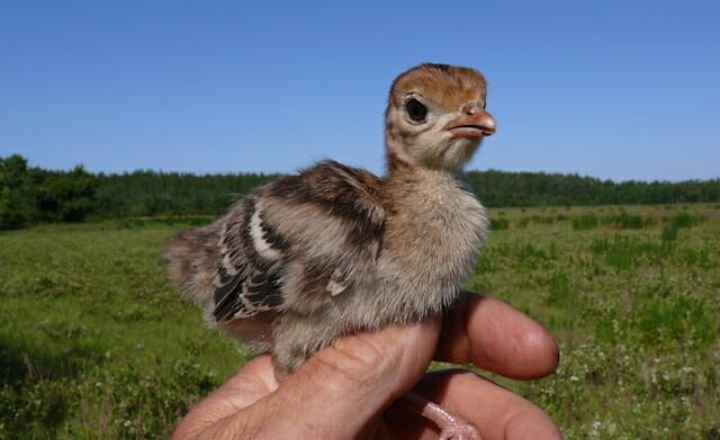Can turkeys fly these plump, majestic birds are often associated with Thanksgiving feasts and farmyard antics, but their aerial abilities remain a topic of mystery and fascination.
While most of us have likely never witnessed a turkey taking flight, the prospect of these seemingly earth-bound creatures soaring through the sky like eagles is enough to spark curiosity.
These large, seemingly clumsy birds have puzzled naturalists and bird enthusiasts alike with their seemingly contradictory traits of heftiness and flightlessness. A Thanksgiving scene where these iconic birds are more commonly associated with being oven-roasted rather than soaring through the sky.
Can Turkeys Fly?
As domestic turkeys, most of them are bred for their meat, leading to larger and heavier bodies that hinder their flight abilities. Domestic turkeys typically lack the strength and agility required for sustained flight, making it rare to see them take off successfully.
The other hand, wild turkeys have evolved differently, with leaner bodies and stronger wings that enable them to fly short distances at impressive speeds.Despite this physical advantage in wild turkeys, they still prefer to spend most of their time on the ground, using flight as a last resort for escaping predators or roosting in trees at night.
Their ability to fly serves as a survival mechanism rather than a primary mode of transportation.
Domestic Turkeys
The inability of domestic turkeys to fly is not just a matter of size and weight, but also a result of their selective breeding for turkeys meat production and management . Their wild counterparts, these commercially raised turkeys are designed to grow quickly and accumulate mass at a rapid pace.
This deliberate breeding has led to physical characteristics that make flight nearly impossible for them.

The wide-breasted white turkeys, especially, with their exaggerated muscle development, face even greater challenges in mobility.Despite their confinement to the ground, domestic turkeys still exhibit some remnants of their wild instincts.
Heritage breeds, known for their more natural attributes and slower growth rates, may occasionally showcase moments of flight.
Wild Turkeys
Despite their reputation as solely ground-dwellers, wild turkeys possess a remarkable ability to take flight when necessary.
Observing these arboreal creatures darting through the forest canopy can be a sight to behold, their wings outstretched and powerful strokes propelling them forward at impressive speeds.

The image of wild turkeys perching on high branches as dusk settles in brings forth a sense of tranquillity and mystery. These birds, steeped in both beauty and resilience, have mastered the art of blending into their wooded habitats while also being adept flyers when danger looms.
Their unique blend of ground-based foraging and skillful aerial manoeuvres adds complexity to our understanding of these fascinating avian creatures that continue to intrigue researchers and nature enthusiasts alike.
The wild turkey’s transition from forest floor to canopy highlights their versatile nature and resourcefulness in finding safe haven turkey in the trees.
Wings of Turkey
Wild and domesticated turkeys have wings that wild turkeys use to fly short distances whereas domestic turkeys do not use their wings at all for flying.Flying habits have been bred out of them, therefore, these wings are useless for domestic turkeys. Their feathers are mostly for show exhibiting different patterns.
Wings of wild and domesticated turkeys are highly cambered meaning that they have appreciable curvature from the leading edge to the trailing feathers.This curvature is better suited for near-the-ground situations. These wings help only when the birds need a great lift in a short period.
Are Turkeys Good Fliers?
Wild turkeys, despite their limited flying capabilities, are surprisingly resilient and resourceful when it comes to defending themselves. They may not be able to sustain long flights like other birds, but they have developed unique survival tactics.

A faced with a threat, wild turkeys can take flight swiftly to seek refuge in high trees or escape predators with remarkable agility. The ability of these famously awkward birds to navigate challenging situations underscores their adaptability in the face of danger.
How Fast Can A Turkey Fly?
Wild turkeys, despite their short flying capabilities, possess impressive survival instincts that have allowed them to thrive in the face of various threats. Their choice to run rather than fly when escaping danger reveals a calculated decision-making process honed by years of evolution.
Opting for their rapid running ability, wild turkeys can outmanoeuvre predators and humans alike, showcasing their agility and adaptability in challenging environments.
Wild Thanksgiving birds, the dynamic between flight and ground behaviour offers a fascinating look into their intricate strategies for survival.
Despite their limited flying skills, wild can turkey fly compensate for this by utilising swift running abilities to evade potential threats effectively.
This dual approach highlights the versatility of these birds and showcases how they have adapted over time to navigate diverse terrains while minimising risks to ensure their continued existence in the ever-changing natural world.
How High Can Turkeys Fly?
The incredible flying prowess of wild turkeys highlights their adaptability and agility in the wild. Their powerful breast muscles propel them skyward, these magnificent birds can reach impressive heights of up to 400 metres during their flight.
Not only are they swift flyers, reaching speeds of up to 55 mph in short bursts, but they also possess the remarkable ability to navigate through dense forest canopies with ease.
Unlike their domestic counterparts, wild turkeys showcase a level of acrobatic grace that allows them to swiftly ascend to traditional roosting sites perched high above at heights ranging from 20 to 30 feet.

This aerial agility not only serves as a means of escape from predators but also enables them to quickly locate safe haven in treetops when night falls. The untamed beauty and resilience of wild turkeys truly shines through as they effortlessly soar through the skies, embodying a sense of freedom and mastery over the vast expanse of nature.
Do Baby Turkeys Fly?
Baby turkeys, or poults, may be unable to fly in the initial weeks of their life, but this delicate phase grants them the opportunity to acclimate to their environment and develop essential survival skills.

With attentive care and proper nourishment, these young turkeys gradually build up their strength and coordination before embarking on their first flight.
The patience required during this period highlights the intricate balance between vulnerability and resilience that characterises the early stages of a turkey’s life.
How Long Can Turkeys Stay Airborne?
Despite their ability to take flight, wild turkeys are not built for sustained flight due to the limitations of their wing muscles. The glycogen in their bodies serves as a temporary source of energy, allowing them to briefly soar through the air before needing to rest.
This unique adaptation sheds light on the delicate balance between flight capabilities and physical endurance in wild turkeys.
Do Turkeys Prefer Flying or Running?
Observing the behaviour of wild turkeys, one can’t help but marvel at their remarkable agility and speed on land. Their decision to run rather than fly in times of peril speaks volumes about their evolutionary adaptations for survival.
The prioritising running over flying, turkeys are able to maximise the use of their powerful leg muscles and maintain a stable stance that is crucial for swift movements on various terrains.
The anatomical features of wild turkeys provide valuable insights into their ground-dwelling lifestyle.
The unique body shape with knees pulled forward and legs splayed not only enhances their running capabilities but also highlights the importance of efficient circulation in facilitating sustained periods of activity on foot.
This emphasises how turkeys have evolved over time to excel as terrestrial creatures, utilising their endurance and speed as primary defence mechanisms against potential threats in their natural environment.
Why Do Only Wild Turkeys Fly?
The difference in flying abilities between wild and domestic turkeys sheds light on the unique adaptations each has developed over time. The powerful breast muscles of wild turkeys not only enable them to take flight but also contribute to their darker meat, a marker of their physical prowess.
Conclusion
While domestic turkeys are unable to fly due to their heavy body structure, wild turkeys are capable of short bursts of flight. Can Turkeys Fly is essential for escaping predators and finding food in the wild. Understanding the physical limitations and capabilities of turkeys can help us appreciate their unique characteristics and behaviours.
Their ability to fly short distances shows that they are more than just ground-dwelling birds. Understanding the limitations of turkey flight can help us appreciate the unique adaptations and behaviours of these fascinating birds.
FAQs
At what age do young turkeys learn to fly?
Young turkeys, also known as poults, typically start to learn how to fly when they are around 2 weeks old. While they are not strong fliers like other birds, turkeys are capable of short bursts of flight to escape predators or reach roosting spots in trees.
How high can a turkey fly when startled or threatened?
Turkeys are not known for their flying abilities, as they are primarily ground-dwelling birds. When startled or threatened, turkeys may attempt to fly short distances to escape danger. Their flight is usually limited to low and quick bursts of up to 55 miles per hour for a short distance of around 100 yards.
Do domesticated turkeys have the ability to fly?
Domesticated turkeys, specifically the broad-breasted white variety commonly raised for meat production, have been selectively bred over generations to have larger bodies and shorter wings. A result, they typically lack the ability to fly long distances or achieve sustained flight like their wild counterparts.
